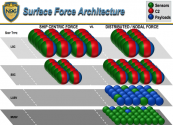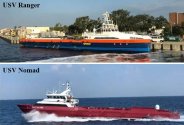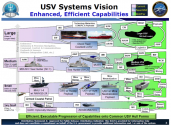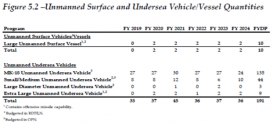You are using an out of date browser. It may not display this or other websites correctly.
You should upgrade or use an alternative browser.
You should upgrade or use an alternative browser.
US Military News, Reports, Data, etc.
- Thread starter tphuang
- Start date
I like it when we get production statistics like this. Raytheon and Northrop will deliver 300 AESA fighter radars in 2022. Also, according to this source the US needs around 150 fighter radars per year to maintain current production and fleet modernization. That is quite a large production volume!
The future of naval warfare will be small, long range robot ships or submarines IMO. I can also see permanent, underseas bases being constructed for these. It would effectively turn the oceans into land.
The future of naval warfare will be small, long range robot ships or submarines IMO. I can also see permanent, underseas bases being constructed for these. It would effectively turn the oceans into land.
Drone ships are good but can’t operate without the support of maintenance crew and staff. I see them as a gear in a system, not the system itself.
That may be true now, but what about in the future? I could see drone ships being operated by AI.Drone ships are good but can’t operate without the support of maintenance crew and staff. I see them as a gear in a system, not the system itself.
If we think of a naval task force as of a moving fortress then right now warships are like medieval castles where everything is packed tightly together because the greatest danger is a ram, a ladder and a trebuchet. A future task force has to contend with the equivalent of artillery and explosive charges so it has to transform into a renaissance fortress with sprawling lines of overlapping battlements USVs are observation towers, battlements and firing positions and the manned ships are the citadel. The purpose of those USVs is to push away enemy information-gathering and force as far away from the critical elements as possible.

The level of complexity of propulsion, power and cooling is too great to completely eliminate crews even in the future. Any damage to those systems can mission-kill the vessel and humans are the most flexible tools for countering damage to ship systems and structure. This is why the unmanned programs that USN is working on at the moment are not intended to replace manned vessels but to introduce distributed architecture for sensors and payloads.
USVs are meant to be cheap and disposable platforms for modular weapon and sensor systems so that a loss of several such platforms doesn't significantly degrade overall capability of the task force.
Below are the two prototypes for the Ghost Fleet Overlord program. The ship which launched the missile was USV Ranger.
As you can see they are commercially derived, low-cost platforms with origin in vessels servicing oil and gas platforms and other undersea infrastructure because those vessels have good sea handling abilities and convenient payload space.

Ranger and Nomad are part of the LUSV program:

Approved budget for naval USVs - FY20-24:

As you can see even the "cheap and disposable" LUSV comes at $270m. Most of it I assume is the cost of combat systems and sensors which are part of the LUSV but not the platform itself. It is still probably at least twice as much of what such vessel should cost to be viable and that's precisely because to be cheap and disposable such ship can't be to survivable. But if the ship is not survivable then it is very easy to disable even if not to sink.
It's going to be an interesting decade as the technology is tested in practice. If I was to speculate I'd say that in the end the LUSV will evolve toward a more traditional arsenal ship - more expensive but more survivable - while a greater share of taks will be carried by the medium and small USVs which will be carried by LUSVs. This current idea seems to me like a first draft using existing fleet as the foundation. It's almost like the "Surface Combatant for the 21st Century" study only 30 years later. Or Predator drones - good for blowing up weddings and kindergartens but not for actual war. But that's just my impression at first glance.
In this opinion I am proably influenced by my general assessment that the USN is increasingly becoming a self-propagating institution for the use of bureaucracy and industry rather than an actual fighting force. It has combat capability because of its size and past investment - especially in submarine and carrier fleets - but otherwise it's inert, confused, very slow to react and struggles to properly innovate even when given the opportunity and resources.

- LSC - Large Surface Combatant (CG, DDG)
- SSC - Small Surface Combatant (FFG, LCS)
- LUSV - Large Unmanned Surface Vessel
- MUSV - Medium Unmanned Surface Vehicle
The level of complexity of propulsion, power and cooling is too great to completely eliminate crews even in the future. Any damage to those systems can mission-kill the vessel and humans are the most flexible tools for countering damage to ship systems and structure. This is why the unmanned programs that USN is working on at the moment are not intended to replace manned vessels but to introduce distributed architecture for sensors and payloads.
USVs are meant to be cheap and disposable platforms for modular weapon and sensor systems so that a loss of several such platforms doesn't significantly degrade overall capability of the task force.
Below are the two prototypes for the Ghost Fleet Overlord program. The ship which launched the missile was USV Ranger.
As you can see they are commercially derived, low-cost platforms with origin in vessels servicing oil and gas platforms and other undersea infrastructure because those vessels have good sea handling abilities and convenient payload space.

Ranger and Nomad are part of the LUSV program:

Approved budget for naval USVs - FY20-24:
| Program | FY20 | FY21 | FY22 | FY23 | FY24 | FY20-FY24 total |
| LUSV (Large Unmanned Surface Vessel) | 372.5 | 535.4 | 584.3 | 607.6 | 638.0 | 2,737.8 |
| MUSV (Medium Unmanned Surface Vehicle) | 23.9 | 26.3 | 30.0 | 43.0 | 43.86 | 167.1 |
| LUSV and MUSV enabling technologies | 50.4 | 199.3 | 177.3 | 247.5 | 132.0 | 806.5 |
| XLUUV (eXtra-Large Unmanned Undersea Vehicle) | 182.0 | 126.1 | 33.5 | 229.9 | 236.0 | 807.4 |
| TOTAL | 628.8 | 887.0 | 825.1 | 1,128.0 | 1,049.9 | 4,518.8 |

As you can see even the "cheap and disposable" LUSV comes at $270m. Most of it I assume is the cost of combat systems and sensors which are part of the LUSV but not the platform itself. It is still probably at least twice as much of what such vessel should cost to be viable and that's precisely because to be cheap and disposable such ship can't be to survivable. But if the ship is not survivable then it is very easy to disable even if not to sink.
It's going to be an interesting decade as the technology is tested in practice. If I was to speculate I'd say that in the end the LUSV will evolve toward a more traditional arsenal ship - more expensive but more survivable - while a greater share of taks will be carried by the medium and small USVs which will be carried by LUSVs. This current idea seems to me like a first draft using existing fleet as the foundation. It's almost like the "Surface Combatant for the 21st Century" study only 30 years later. Or Predator drones - good for blowing up weddings and kindergartens but not for actual war. But that's just my impression at first glance.
In this opinion I am proably influenced by my general assessment that the USN is increasingly becoming a self-propagating institution for the use of bureaucracy and industry rather than an actual fighting force. It has combat capability because of its size and past investment - especially in submarine and carrier fleets - but otherwise it's inert, confused, very slow to react and struggles to properly innovate even when given the opportunity and resources.
Last edited:

